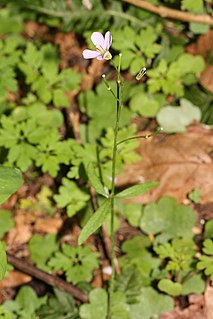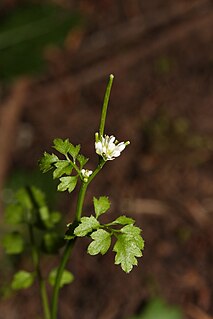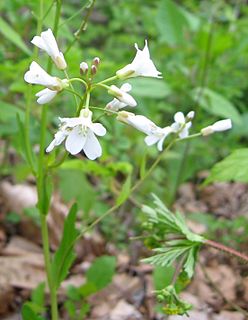
Anthocharis cardamines, the orange tip, is a butterfly in the family Pieridae, which contains 1100 species of butterfly. A. cardamines is mainly found throughout Europe and temperate Asia (Palearctic) The males feature wings with a signature orange pigmentation, which is the origin of A. cardamines' common name.

Anthocharis midea, the falcate orangetip, is a North American butterfly that was described in 1809 by Jacob Hübner. It belongs to the family Pieridae, which is the white and sulphurs. These butterflies are mostly seen in the eastern United States, particularly in Texas and Oklahoma. They eat the nectar of violets and mustards. They tend to live in open, wet woods along waterways, in open swamps, and less often in dry woods and ridgetops. This species is a true springtime butterfly, being on the wing from April to May.

Cardamine pratensis, is a flowering plant in the family Brassicaceae, native throughout most of Europe and Western Asia. The specific name pratensis is Latin for "meadow."

Cardamine californica (Milkmaids) is a flowering plant in the family Brassicaceae, native to western North America from Washington to California and Baja California. It is common in a variety of habitats including shady slopes, open woodlands, chaparral and grasslands in the winter and early spring. In the San Francisco Bay Area, it is one of the first wildflowers to bloom, with blossoms from January to May.

Cardamine hirsuta, commonly called hairy bittercress, is an annual or biennial member of the mustard family (Brassicaceae), and is edible as a bitter herb. It is common in moist areas around the world.

Cardamine concatenata, the cutleaf toothwort, crow's toes, pepper root or purple-flowered toothwort, is a flowering plant in Brassicaceae. It owes its name to the tooth-like appearance of its rhizome. It is a perennial plant woodland wildflower native to eastern North America. It is considered a spring ephemeral and blooms in March, April, and/or May.
Cardamine digitata, is an ornamental plant of Brassicaceae family, which is native of Alaska and Canada.

Cardamine impatiens, the narrowleaf bittercress or narrow-leaved bitter-cress, is a plant species of the genus Cardamine belonging to the family Brassicaceae. It is a slender, biennial herb, that produces sterile leaves in the first year, one to several flowering stems during the next. Its leaves are pinnate with several pairs of lanceolate, dentate leaflets and a terminal, slightly longer leaflet. The short petals surpass the calyx by half of its length. The seeds are arranged in one row on each side of the central membrane of the narrow pod and are ejected out in a shower due to the tension formed as the seed pod (silique) dries. It grows on walls, open ground in shady places in forests usually disturbed by man.

Cauchas rufimitrella is a diurnal lepidopteran from the family Adelidae, the fairy long horn moths. It is found in almost all of Europe, except Portugal, Ukraine and the southern part of the Balkan Peninsula.

Cardamine breweri is a species of cardamine known by the common name Brewer's bittercress. It is native to western North America from British Columbia to California to Colorado, where it grows in coniferous forests, particularly in wet bog habitats.

Cardamine nuttallii is a species of cardamine known by the common name Nuttall's toothwort. It is native to western North America from British Columbia to California, where it grows in moist mountain habitats.
Cardamine occidentalis is a species of cardamine known by the common name big western bittercress. It is native to western North America from Alaska to northwestern California, where it grows in moist mountain habitats.

Cardamine oligosperma is a species of cardamine known by the common name little western bittercress. It is native to western North America from Alaska to California to Colorado, where it grows in moist mountain habitats.
Cardamine pachystigma is a species of cardamine known by the common name serpentine bittercress. It is endemic to California, where it grows in rocky mountainous areas, often on serpentine and volcanic soils.

Cardamine corymbosa, commonly known as the New Zealand bitter-cress, is a flowering plant in the cabbage family, Brassicaceae. Native to the subantarctic islands of Australasia, it has become an invasive species in plant nurseries. The specific epithet refers to the structure of the inflorescence.

Cardamine angustata is a perennial forb native to the eastern United States, that produces white to pink or purple flowers in early spring.

Cardamine flagellifera, commonly known as Blue Ridge bittercress, is a species of herbaceous plant in the mustard family. It is native to eastern North America, where it is found primarily in the southern Blue Ridge. It is a perennial that produces white flowers in the spring.















